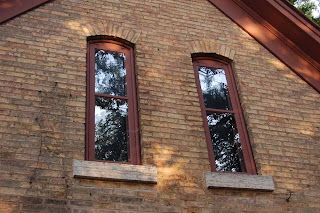“What style is my house?” This is a common query from homeowners as they wonder how their home fits into the local architectural landscape. This is, however, a question that can be difficult to answer. Is a house a Victorian, Folk Victorian, National Folk, Vernacular, Queen Anne, Italianate, Second Empire or something else? Answers depend on the eye of the beholder and the ways different people classify houses. Each observer focuses on particular architectural features and creates categories that reflect their own perspectives on style and history. Since such categories are arbitrary as people try to organize disparate things, there often isn’t agreement on which style a house represents.
The Cummins house in Eden Prairie, MN is a good example. The house was built between 1879 and 1880 by John R. Cummins, a prominent farmer and horticulturalist. The house is constructed of Chaska brick, a cream colored brick manufactured in nearby Chaska, MN, in the classic gable and wing form.

Most people would recognize it in a general sense as a Victorian, and they would be correct. But what else can we say about its architectural style? Its listing on the National Register of Historic Places describes it as having both Greek Revival and Italianate features, including wide frieze boards, eave returns and segmented arched windows.

Segmented arch windows are common the Italianate homes just as wide frieze boards and eave returns are common on Greek Revival homes. So, does this mean the Cummins house is a Italianate/Greek Revival hybrid? Actually, no. Many Italianate brick homes do have similar windows, but not all segmented arched windows are Italianate. The same is true for the trim and eave returns.

This really gets at the heart of the matter. 19th century houses are often divided broadly into two categories: High Style and Vernacular. High Style homes were designed by trained architects or master builders to suit the tastes of a client and complement a particular setting. These homes are more easily attributed to particular styles such as the Queen Anne or Second Empire. Vernacular homes were designed and built by local tradesmen or the homeowners themselves using simple forms such as the gable-and-wing or the side-gable. Often using pattern books as a guide, builders incorporated decorative details from High Style examples into their own designs. This was especially common after the arrival of railroads, which allowed the distribution mass-produced architectural elements such as brackets, spindles, turned porch posts and barge boards.
However, the use of the term Vernacular can be problematic. That is because new vernaculars are created through time. Immigrants brought vernacular building traditions with them from their home countries and utilized these in the United States wholly or in part when they built their new homes. We see homes and other buildings that closely resemble precedents in Norway, Germany and England. And yet, new vernaculars were created here as styles, forms and functions continued to evolve and change. Indeed, the houses built in the last half of the 19th century using factory made ornament and based on pattern books were, in fact, a new type of Vernacular.
This new sort of vernacular homes, which would include the Cummins House, are sometimes classified into sub-categories such as Folk, National Style, Folk Victorian or could simply just be called Vernacular. All these terms are common and some observers make the following distinctions between them. Some use the term National Style to describe homes constructed throughout the United States using simple, popular forms such as the gable-front, gable-front and wing, the hall-and-parlor and the I-house. These homes usually have little ornament and are utilitarian. Builders of Folk Victorian homes utilized these same, simple forms, but decorated them with Victorian era detailing found on High Style homes such as the Queen Anne or Italianate. The decoration on these homes is often quite eclectic as the builders used whatever ornament they liked in any manner that suited them. Others use the term Vernacular to refer more broadly to these late 19th and early 20th century homes that were inspired by pattern books and built with machine made, mass produced components (indeed, many later examples were kit homes bought from companies such as Sears or Aladdin).
Confused yet? If you are, I don’t blame you. Classifying houses by building style is very different than a biologist classifying organisms using DNA. All these house styles and distinctions are artificial constructs we devise to make the great variety of buildings more comprehensible. In many respects, the way we classify houses is subjective and tells us more about the observer than the building itself. Although it is quite easy to identify a High Style Second Empire home, a home like the Cummins House is more challenging.
So, with all that being said, what style is the Cummins house? My vote is Folk Victorian.
0 Comments